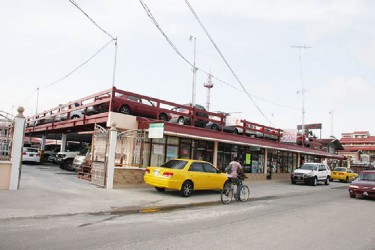Fourteen months ago, S&R Parking Lot at 162 Parika, East Bank Essequibo became part of the growing range of services created to cater for what is one of the fastest growth industries in Guyana, the acquisition of motor vehicles.
With dozens of privately-owned vehicles hitting the roads across Guyana every month, the demand for safe and convenient parking has grown to a point where prime pieces of real estate are being transformed into commercial parking lots.
In Georgetown, the customary confusion associated with parking has been accentuated by the location of the Guyana Revenue Authority inside a single complex in Camp Street. There was a need to acquire several lots in the vicinity to serve as parking space, as the parapets on the Camp Street block where the GRA is located quickly became fully occupied to the considerable inconvenience of moving traffic.
One might have thought that being the country’s capital, Georgetown may have taken the lead in creating modern facilities designed to ease the increasingly frustrating parking problem. Not so. The 14-month old, multi-million-dollar, two-tiered structure at Parika leads the way countrywide in terms of single parking spaces.

Shireen Kunjbeharry, the facility’s owner, walked Stabroek Business through the evolution of the service, pointing out that it arose out of the development of Parika as the centre of a business hub and a convenient stopover en route to the other, busier side of the Essequibo River.
Almost 20 years ago, part of the plot on which the parking lot now stands had served as free parking space for travellers to the Essequibo Coast whose vehicles could not be accommodated on the cramped ferry. “It began as a favour to a family from Berbice,” Kunjebeharry said. Afterwards, the prospects of an established business emerged, but then the Kunjbeharrys migrated leaving a relative to continue what, up to that point, was an underdeveloped business. It was only after her return to Guyana that Kunjebeharry began to contemplate the expansion of the existing service.
The construction of the present car park commenced in 2010. By this time the number of users of the open car park—mostly business travellers to Essequibo, including its various islands and the goldfields of the interior—had increased significantly.
In North America, Shireen had observed the manner in which multi-storeyed parking facilities were being employed to get around the challenge of safe and convenient spaces. She had visited some of these facilities and taken pictures, becoming increasingly convinced of the suitability of the business model to her own circumstance at Parika.
The challenge reposed in having the facility constructed. Safety, she was aware, was by far the most important issue in a service of that nature and nothing like that had ever been constructed in Guyana before.
It took a while to find a willing and capable contractor but eventually she did. Mohan Motilall, a contractor from the East Coast Demerara stepped up and construction began.
Up to this time good fortune was sticking with Kunjebeharry. Apart from the fact that the availability of two adjoining lots for sale meant that she could now embark on an expanded project, a local commercial bank decided to finance the initiative.
A small squall struck the project in 2011. The government announced that it would build a similar facility in the area and the concern arose as to whether there would be room for two such services. That notwithstanding, Kunjebeharry was determined to persist and almost a year and a half after the significant expansion of her business no competition has materialised.
The parking complex is a steel structure with accommodation for 102 vehicles. Since the structure has no roof, customers usually prefer the cover provided by the lower floor. Kunjebeharry said preference is given to “regulars,” particularly those customers who often leave their vehicles for periods in excess of a week. She said these days, most of her regular customers are miners, loggers and other people with businesses in the interior. It costs $500 a day to park at the S&R Parking Lot. Four other business enterprises, including a hair dressing salon and a cell phone shack are housed on the bottom deck.
The parking procedure can take a while. Drivers must secure a ticket and before parking, the vehicle must be inspected since the proprietors of the S&R Parking Lot are liable for any damage that occurs while the vehicle is in their keep.
One of Kunjebeharry’s regrets is that the ticket machine does not photograph vehicles and record registration numbers. The S&R Parking Lot provides other services too, like occasional turning over of engines and washing of vehicles left for three months or more.
Even after 14 months, Kunjebeharry still believes that it is too early to make a pronouncement on the long-term prospects of the enterprise. She is, however, encouraged by its growth and by the fact that the car import business continues to grow apace.





